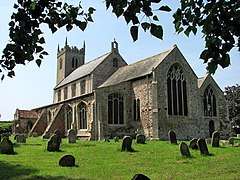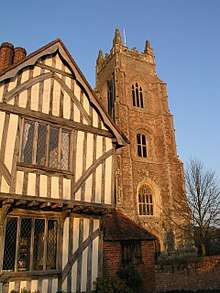John Howard (died 1437)
Sir John Howard (c.1366-1437), of Wiggenhall in Norfolk, was an English landowner, soldier, courtier, administrator and politician. His grandson John Howard became Duke of Norfolk and was grandfather of both Anne Boleyn and Catherine Howard, wives of King Henry VIII.[1]

Origins
Born about 1366, he was the son and heir of Sir Robert Howard (died 1389), of Wiggenhall, and his wife Margaret (died 1416), daughter of Robert Scales, 3rd Lord Scales, and his wife Catherine, the daughter of Robert Ufford, 1st Earl of Suffolk. His grandfather Sir John Howard (died 1364), had served as Admiral of the northern fleet from 1335 to 1337 and had married an heiress Alice, daughter of Sir Robert de Boys, of Fersfield.[1]
Career
By 1380 he was married to an heiress and had been knighted by March 1387, when he served at sea in the fleet commanded by Richard FitzAlan, 11th Earl of Arundel that fought the French and their allies. In 1389 both his father and his father-in-law died, bringing him most of the paternal lands as well as those inherited by his wife, which he retained for life when she died in 1391. These estates gave him not only a considerable income but also local influence.[1]
In 1394 he was appointed a member of the Royal Household for life, serving in the English expedition that year against Ireland. In 1397, by which time he had married another heiress, he was made a justice of the peace (JP) for both Suffolk and Essex and in September was elected a Member (MP) of the Parliament of England for Essex. This Parliament was used by King Richard II to penalise his opponents and, on behalf of the Crown, Howard was empowered to seize the estates of rebel nobles and to collect large fines from the dissident counties of Essex and Hertfordshire. He then accompanied the King on his second expedition to Ireland in 1399.[1]
His position in the Royal Household was not renewed under the new reign of King Henry IV but he continued to sit as a JP and serve on royal commissions. He served the first of two terms as High Sheriff of Essex and Hertfordshire in 1400, during which he was summoned to the Great Council of August 1401, and was High Sheriff of Cambridgeshire and Huntingdonshire in both 1401 and 1402. In 1407 he returned to Parliament as MP for Cambridgeshire.[1]
In 1408 his wife's father died and she inherited his lands. Chosen again as Sheriff of Essex and Hertfordshire in 1414, he was involved in preparations for the first expedition to France of the new King, Henry V. In 1420 he was in difficulty over a feud in Suffolk with the influential MP Sir Thomas Kerdiston, which Sir Thomas Erpingham reported to the Privy Council, but by 1422 was sufficiently in favour locally to be elected Suffolk's MP.[1]
After sitting in this third Parliament, and following the death of his second wife in 1426, he took less part in local administration, though continuing as a JP and on royal commissions. In February 1436 he was asked to contribute 100 marks to the cost of the Duke of York’s expedition to France.
He then went on pilgrimage to the Holy Land, where he died in Jerusalem on 17 November 1437. His remains were brought back to England and buried beside his second wife at Stoke-by-Nayland.[1]

Landholdings
Through both his parents and through his two wives, he acquired estates in several adjoining counties, among them:
- In Norfolk: Wiggenhall, Fersfield, East Winch, five manors near King’s Lynn, Garboldisham, Toft, Weeting and Knapton.[1]
- In Suffolk: Stoke-by-Nayland, Chelsworth, and Brook Hall near Dunwich.[1]
- In Essex: Stansted Mountfichet, Oakley and Moze.[1]
- In Cambridgeshire: Fowlmere.[1]
After the death of his eldest son in 1409, leaving an only daughter as heiress, he settled many of these properties on this granddaughter and, when she married in 1425, he assured John de Vere, her husband, that many more would follow. His second son then died in 1436, leaving a grandson, John Howard, as the heir to be provided for. After his own death in 1437, bitter feuds over the inheritance broke out between the de Veres and the Howards, which continued into the Wars of the Roses, in which both John de Vere and John Howard lost their lives.[1]
Family
In about 1380 he married Margaret, daughter and heiress of John Plaiz, 5th Lord Plaiz, and his second wife Joan, daughter of Sir Miles Stapleton, of Bedale, and his second wife Joan, daughter of Sir Oliver Ingham.[1] They had one son:
- John (died 1409), who married Joan, daughter of John Walton, of Wivenhoe, and his wife Margaret Sutton, and had a daughter:[1]
- Elizabeth (died 1475), who in 1425 married John de Vere, 12th Earl of Oxford.[1]
Margaret died in August 1391, and by June 1397 he had married Alice, only daughter and heiress of Sir William Tendring (died 1408), of Stoke-by-Nayland, and his wife Catherine (died 1402), widow of Sir Thomas Clopton, of Kentwell Hall at Long Melford, and daughter of William Mylde, of Clare.[1] They had two sons:
- Robert (died 1436), who in 1420 married Margaret (died 1459), daughter of Thomas Mowbray, 4th Earl of Norfolk, and had three children, including:
- John, who became Duke of Norfolk.[1]
- Henry (died 1446).[2]
Alice died on 18 October 1426 and was buried at Stoke-by-Nayland.[1]
References
- J.S. Roskell; L. Clark; C. Rawcliffe (eds.), "Howard, Sir John (c.1366-1437), of Wiggenhall and East Winch, Norf., Stoke Nayland, Suff., Stansted Mountfichet, Essex, and Fowlmere, Cambs.", The History of Parliament: the House of Commons 1386-1421, retrieved 27 February 2018
- Ross, J. A. (2011). ""Mischieviously Slewen": John, Lord Scrope, the Dukes of Norfolk and Suffolk, and the Murder of Henry Howard in 1446". In Kleineke, H. (ed.). The Fifteenth Century X: Parliament, Personalities and Power. Papers Presented to Linda S. Clark. Woodbridge: Boydell and Brewer. ISBN 9781843836926.CS1 maint: ref=harv (link)